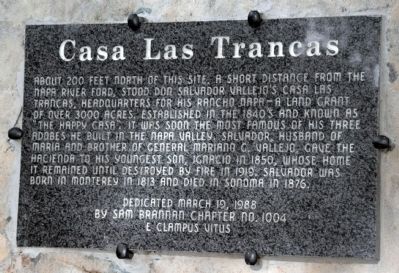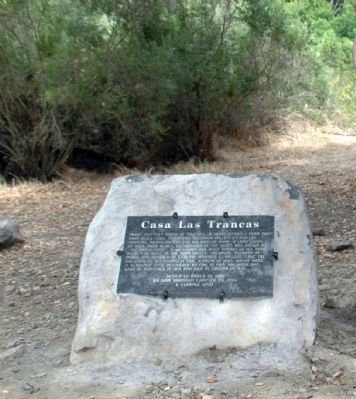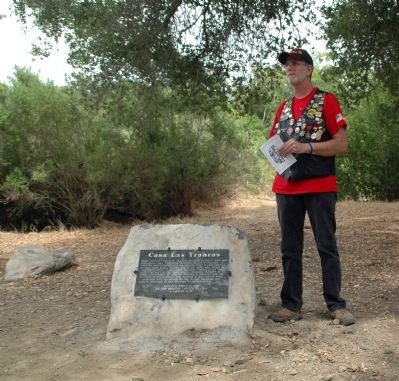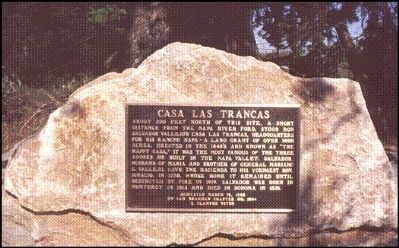Napa in Napa County, California — The American West (Pacific Coastal)
Casa Las Trancas
Dedicated March 19, 1988
By Sam Brannan Chapter No. 1004
E Clampus Vitus
Erected 2015 by Sam Brannan Chapter E Clampus Vitus.
Topics and series. This historical marker is listed in these topic lists: Hispanic Americans • Settlements & Settlers. In addition, it is included in the E Clampus Vitus series list. A significant historical date for this entry is March 19, 1773.
Location. 38° 19.56′ N, 122° 17.104′ W. Marker is in Napa, California, in Napa County. Marker can be reached from Trancas Street. The plaque is located in Trancas Crossing Park Just downhill from the park entrance, under an oak tree. Touch for map. Marker is at or near this postal address: 601 Trancas Street, Napa CA 94558, United States of America. Touch for directions.
Other nearby markers. At least 8 other markers are within 2 miles of this marker, measured as the crow flies. Lisbon Winery 1882 (approx. 1.6 miles away); Johnson-Doran Building (approx. 1.7 miles away); Pfeiffer Building (approx. 1.7 miles away); Napa's China Town / Shuck Chan (approx. 1.8 miles away); Winship Building 1888 (approx. 1.8 miles away); Semorile Building (approx. 1.8 miles away); Napa - Birthplace of the Loudspeaker and the Magnavox Corp. (approx. 1.9 miles away); Oberon Saloon (approx. 1.9 miles away). Touch for a list and map of all markers in Napa.
More about this marker. This original plaque, erected in 1988 and located only a few hundred feet away, was stolen for the brass about 2005. Sam Brannan Chapter replaced the plaque, with the help of the City of Napa, with a granite marker in Trancas Crossing Park, which did not exist in 1988.
The new plaque was dedicated on June 3rd, 2015, Jeff O' Brien was Noble Grand Humbug. Plaque wording by Loren Wilson XNGH #10
Regarding Casa Las Trancas. SALVADOR VALLEJO AND HIS CASA LAS TRANCAS
Lieutenant Joseph Warner Revere observed in his Duty in California (1849) that in the Napa Valley, 'The climate is a perpetual summer and the atmosphere is not obscured by the fogs which prevail nearer the sea. In the rainy season ('twere treason against nature to call it winter) the rushing and picturesque cataracts descend from the Sierras on either side, over beds dry at all other times of the year, swelling the River Napa to its fullest dimensions. The exquisite views which abound in every direction, the complete seclusion of the spot, bounded at the broader end by the waters of the bay, and at every point by jagged mountain crags, realize the ideal of a 'happy valley'."
This was the setting which Salvador Vallejo chose for the establishment of his home. Sonoma Valley was Mariano's homeland, the seat of his branch of the family, and a heritage for his children. It was Salvador's idea that his own family should have a similar heritage, and it seemed to him appropriate that the two brothers should hold the two parallel valleys, both sloping southward to the waters of the bay and separated by a densely wooded ridge. The Petaluma Valley west of Sonoma was already held by Mariano and was the center of his agricultural activities.
On the west bank of the Napa River near what was first called Trancas Ford, Salvador built his home, which he called "Las Trancas," meaning "The Bars." It was large; more than 40 feet long with walls two feet thick and 14 feet high that kept it cool in summer and warm in winter. The living-room was floored, half with gray stone, half with hewn planks.
Casa las Trancas, the “house of the bars,” stood just at the tide-water on the Napa River. Here was the ford, the first crossing north of the Bay. The herds of cattle soon found that here the river could be crossed and to prevent the cattle straying, a pair of bars was built. Two small redwoods were cut and hewed square. These timbers, about 18 inches square and 30 feet long, were dragged by oxen from the hills on the west side of the valley, a distance of five miles to the ford.
Here they were placed one on each side of the river, holes cut in them at intervals and uprights placed in the holes. This made the first pair of gates in Alta, California, and the "Trancas" was a land mark for all north-bound travelers.
Salvador had become a captain while serving in the Mexican army. He fought alongside his brother, General Mariano Vallejo, and also George C. Yount. After the Indian fighting had slackened, he tried his hand at trapping sea otter off the Marin coast. He also engaged in the making of grinding and mill stones.
By 1838 he had applied for and received his Napa rancho. Like all the great rancheros of the 1840s, he counted his riches largely in livestock. He was said to own at one time five to six thousand cattle and 2,000 horses. When Lieut. Charles Wilkes visited California as head of a scientific expedition sent out by the United States in 1841, he entertained on shipboard the two Vallejo brothers, and noted in his record of the visit: "Salvador Vallejo is engaged in agricultural pursuits and particularly in cattle raising which under the government has the special privilege of supplying the vessels which he does at prices which insure a special profit”.
Salvador also raised wheat. In addition to his agricultural activities, Salvador operated a soap factory at Napa for several years, which is said to have brought him several thousand dollars a year.
Salvador was prosperous. He had diversified interests that seemed to guarantee a safe future for himself and his family. And he was generous to the stream of overland immigrants who were reaching the central and northern valleys of California in various states of destitution. According to Nicholas Carriger, one of a party which had just arrived from across the plains and were camped at Sonoma Creek: "Captain Salvador Vallejo came to us in his undress uniform led by three stalwart Indians, one groaning under a heavy load of flour, one carrying a basket of sugar, and the other holding a basket of chocolate; the Captain by means of one interpreter asked us if we were in need of any one of the articles his servants carried, and expressed his willingness and readiness to serve us to the full extent of his ability. On taking a farewell from us, he said “Nearby, I have 1,000 cows. If any of you wish fresh meat, go and kill as many animals as you need for your daily support”. Captain Salvador Vallejo observed the same conduct toward every other emigrant camped in the vicinity of Sonoma. Because of the generosity of Salvador and his wife, Maria de la Luz Carrillo, the house was famous from San Diego as far north as the Spanish and Mexican culture had reached. Known not only for his generosity and as an adept Indian fighter, Salvador was also known for his quick temper that caused embarrassment and ridicule. He had Dr. Edward Bale flogged in Sonoma for alleged aspersions Bale had issued against Vallejo's character. Some time later Bale retaliated by shooting Vallejo, grazing him in the neck. Salvador was locked up with his brother Mariano at Sutter's Fort on the orders of Capt. John Charles Fremont in the aftermath of the Bear Rag Revolt. In 1849 Ignacio Vallejo, fifth child of Salvador Vallejo, was born in the general's house at Sonoma. When he was one year old, his father deeded to him Casa las Trancas, with all the land surrounding it. This little birthday present was an enduring one. The building was later added to and was occupied by its owner, Ignacio Vallejo, for many years.
Salvador Vallejo was born in Monterey, California, on January 1, 1813. He was living with his brother, General Mariano Vallejo, in Sonoma when he died on February 17, 1876. He had been living with him on and off for some 12 years before his death. This wife, Maria, continued to live on at Casa las Trancas, in what is now the City of Napa.
In 1919, 69 years after its presentation to him by his father, Ignacio returned one day to find his home destroyed. A modern oil stove had exploded and the interior and roof burned. The adobe walls, no longer protected from the rains of winter, melted and by spring nothing was left but a pile of earth. A rather ignoble ending for such a relic of our first European civilization, but the memory of the Vallejo’s fortunately reconstructs for us the scenes which centered around this house. Loren A. Wilson, XNGH #10, 1988
Credits. This page was last revised on June 16, 2016. It was originally submitted on June 4, 2015, by Loren Wilson of Sebastopol, California. This page has been viewed 632 times since then and 30 times this year. Photos: 1, 2, 3, 4. submitted on June 4, 2015, by Loren Wilson of Sebastopol, California. • Andrew Ruppenstein was the editor who published this page.



